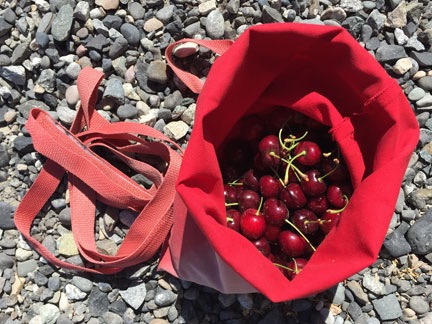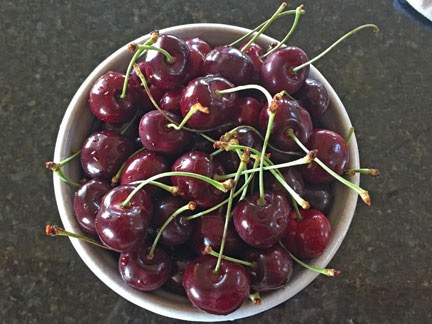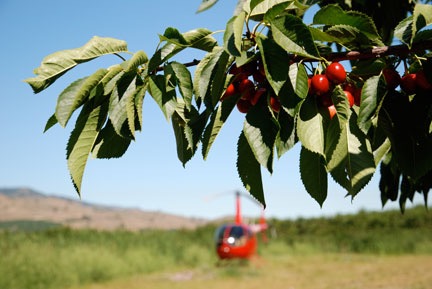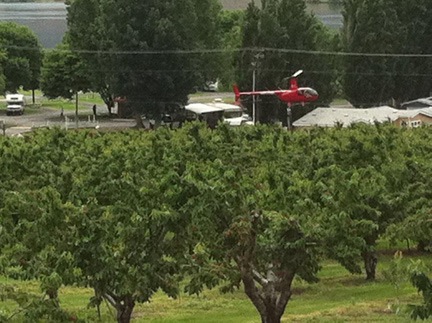A few tips from years of experience.
One of the perks of my summer job as a cherry drying pilot is my friendship with more than a few orchard owners. As a result, I often find myself with an opportunity to pick cherries right off the trees for my own personal consumption.
Gleaning
I got an opportunity just yesterday. I was on a charter flight with two good clients who occasionally use a helicopter to visit multiple orchards during the growing season. Our first stop was a cherry orchard about forty miles south of my base in the Wenatchee area. Picking was in full swing, with lots of pickers working on trees just to the south of the clearing where I’d landed. I wandered off into the orchard in the other direction and found large, mature trees. I stepped into the shade and looked around me.
Most of the trees were Bing cherry trees. I could tell because I know that Bings don’t self-pollinate, which would explain the presence of Rainier cherry trees, which are sometimes used as pollinators. There was another type of cherry tree there too — likely another pollinator. The Bings had been picked; the Rainiers and other cherries had not.
I have a lot of respect for my client, which is why I didn’t pick any Rainiers. Instead, I went to the picked Bing cherry trees and began my hunt. I was gleaning.
According to Wikipedia:
Gleaning (formerly ‘leasing’) is the act of collecting leftover crops from farmers’ fields after they have been commercially harvested or on fields where it is not economically profitable to harvest.
(I was not familiar with this term until last year, when I described what I was doing and a friend told me it was called gleaning. I never stop learning and hope you don’t, either.)
I’m pretty good at gleaning, having had lots of experience over the past eight years. As strange as it may seem, when pickers go through an orchard, they often leave a lot of fruit behind. I’ve noticed that some trees have more leftover fruit than others, likely because some pickers are not quite as good as others. I’ll go for good sized, unblemished fruit that I can reach from the ground. (Being tall helps.) It doesn’t matter what I pick or how much — since the trees have already been harvested, if I didn’t pick the fruit it would likely rot there. One of my clients even told me that by gleaning the leftover cherries, I help prevent the spread of a certain pest that thrives on rotting fruit.

Robinson R44 blade tie-downs make pretty decent little canvas bags. I could have put at least five pounds in this one.
I picked about two to three pounds of cherries. I put them in one of my helicopter’s blade tie-downs, which actually makes a good-sized canvas bag. (I can’t take credit for this idea; a pilot friend of mine used one of his tie-downs Thursday as a bag on a kayak trip.) I stowed it under my seat for the trip home, knowing how important it is to keep the cherries cool.
And that’s the trick: keeping the cherries as cool as possible.
Keep the Cherries Cool
Cherries begin to lose their freshness as soon as they are picked. Growers do everything they can to keep the fruit as cool as possible. They only pick early in the day and seldom after the outside air temperature reaches 80°F. If able, they run the bins of freshly picked fruit through a hydrocooler to drop the temperature of the fruit. They get the bins of fruit into refrigerated trucks as quickly as possible. Even at the packing house, the fruit is moved off the trucks and into huge refrigerated warehouses until they can get a place on the packing line.
I have my own hydrocooler of sorts: a kitchen sink or large bowl of cold water. As soon as I got yesterday’s cherries home, I rushed them into the kitchen, dumped them into a bowl, and filled the bowl with cold tap water. I whooshed them around in the water to wash off the orchard chemicals and dumped the water. Then I did it again. And again. Three washes — that’s my routine.
Next, I half-filled the bowl of cherries with water and topped it off with ice from my freezer. (Before I moved out of my RV and into a real home, I actually bought bags of ice that I stored in my RV freezer just for this task.) I whooshed the cherries around in the water, getting the water and the cherries icy cold.
The important thing to remember here is to not leave the cherries in water longer than necessary. Why? Because they will split. After all, that’s why I work as a cherry drying pilot — to get rainwater off cherries so they don’t split.
So my next step was to dump the cherries with the ice into a colander. That would allow the water to drain off while keeping the ice around the cherries to cool them just a little bit more.

I keep the cherries on ice a while to keep cooling them down.
Then I ate some. Quite a few, in fact. Although some people seem to have digestive problems when they eat too many cherries, I don’t. I can eat a lot of cherries.

My gleaned cherries, ready for the fridge.
Finally, I pulled the cherries out of the colander and put them in a ceramic bowl, leaving the ice behind. And I put the bowl in the fridge, where I could easily reach in for a handful of cherries any time I liked.
Sealing Out the Air
Every once in a while, I pick a lot of cherries — more than I can eat in a day or two — or one of my clients gives me an 18-pound box. 18 pounds is a lot of cherries.
Besides making cherry turnovers, cherry cobbler, and cherry chutney, eating cherries with yogurt and cereal, and sealing pitted cherries in jars with vodka and a bit of sugar to enjoy six months into the future, I want to store the cherries in a way that’ll keep them fresh for munching as long as possible.
To do this, I follow all the steps above and then add a final step: store them in a zip-lock bag with air sucked out of it. I suck the air out with a straw, just before sealing the bag. Then I put the bags in the coldest part of the fridge. I’ve managed to keep cherries edible for up to two weeks like this.
I Love Washington State Cherries
The only fresh cherries I eat are Washington state cherries, most of which are grown within 50 miles of my home.
Whenever possible, I pick them myself, after the pickers have gone through the orchard block. I’m picking up the crumbs, taking fruit that would just go to waste otherwise. I feel very fortunate to have the opportunity to do this. It’s not just a matter of getting free cherries. It’s also a great way to get closer to my food source, seeing how the fruit grows and fades, getting a better appreciation for what it takes to grow and harvest the food we take for granted.
Washington state cherry season will likely end early this year — possibly before the middle of August. There isn’t much time left to get this great fruit. If you find some in your local supermarket, buy it, bring it home quickly, and chill it back down. Then come back here and use the comments to tell us what you think.





